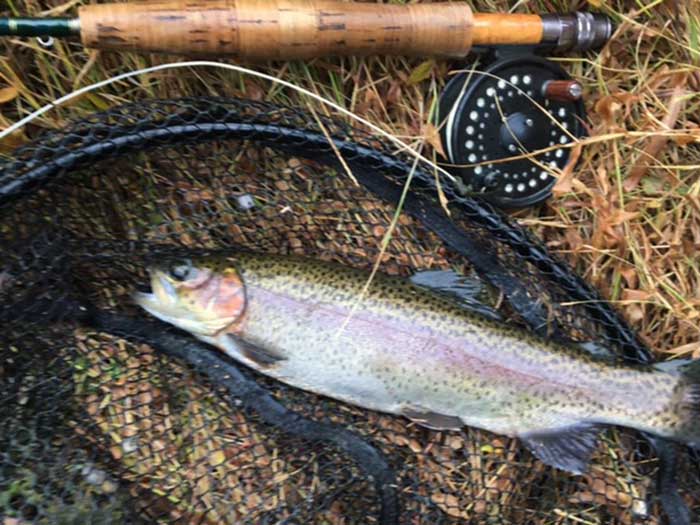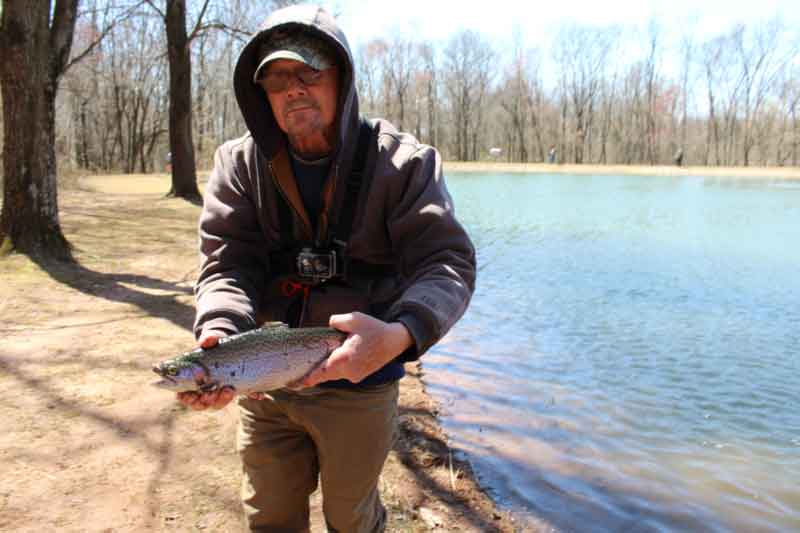Known for their beautiful, colorful patterned appearance, and an amazing ability to swim upstream, rainbow trout are a great fish to catch any time of the year. Rainbow trout are special because their high adaptability allows them to be stocked yearly, all over the world. Perhaps this is why they’re the most widely cultivated trout species in the world. Not only are they fun to fish for as one of the top five game fishes in North America, but hatchery fish are easy to catch, too. And the flavor of rainbow trout is nothing to scoff at, with their mild, nut-like taste and tender flaky skin. For beginners who want an easy-going trip to their local hatchery-stocked pond or river, rainbow trout are the perfect fish.

What are Rainbow Trout?
Rainbow trout are a member of the Salmonid family, native to cold-water tributaries in the eastern Asia and North America. They have been introduced from the west coast to nearly every state in the U.S., plus every continent except Antarctica. Rainbow trout’s natural habitats are rivers, streams, and other freshwater bodies. Some rainbows are anadromous, and these are known as steelhead trout. But the trout found in the DelMarVa region, which are mostly hatchery trout, are not.
Fun fact: Rainbow trout are classified as one of the top 100 invasive species in the world because of their widespread introduction to habitats they are not native to. However, they are not considered invasive in the Mid-Atlantic.
Rainbow trout look different depending on where they are, how big they are, and when their spawning period is. We’ve narrowed down the rainbow trout identification for you to a few characteristics: in general, rainbows are olive green on the back, the sides are silvery, and the underbelly is white. Of course, rainbow trout are famous for that colorful pink coloration which runs along the length of their body. Also, rainbow trout often have a lot of small black spots on their back, fins, and tail. Rainbow trout have an average lifespan between five to six years. With hatchery raised trout it’s hard to pin down their weight or length, but they can weigh anywhere between two and 16 pounds and their average length is 20 to 30 inches.
Record Rainbow Trout
There’s a lot of competition out there for this gamefish, but can you beat these record fish? Here are the current state records for rainbow trout caught in the Mid-Atlantic region:
Delaware - In 1997, Edwin Wallace caught a golden rainbow trout in White Clay Creek weighing 11 pounds and 10 ounces.
Maryland - The non-tidal record for rainbow trout is held by Dave Schroyer, at 14.2 pounds, caught at Savage River Reservoir all the way back in 1987.
Pennsylvania – In trout-popular PA the record rainbow is a 15 pound, six ounce fish that was caught by Dennis Clouse in Jordan Creek, in 1986
Virginia - The Virginia record sits at 14 pounds and seven ounces, caught by Michael Lowe at Greers Pond in 1993.
Rainbow Trout Seasonal Availability
Rainbow trout are one of the Mid-Atlantic’s best breeds for fishing any time of the year. One could say that rainbow trout season is open year-round, and this would not technically be wrong. However, it’s a little more complicated than that because of stocking. While some states in the Mid-Atlantic region have a rainbow trout open season year-round, anglers who are looking forward to catching hatchery trout must first check the state agency stocking schedules of their state because there are often pre- and post-stocking closures for specific bodies of water.
To see when and where hatchery raised fish will be released and when it’s legal to fish for them, follow these links to stocking programs in the Mid-Atlantic region:
Virginia Trout Stocking Schedule
Picking the right season really just comes down to preference. Maybe you prefer ice fishing in winter — or maybe not because you don’t want to freeze your butt off. Fall is a good choice for those who want the advantage of cool waters, but not too cold. A major perk of spring fishing is that most stocked waters are put-and-take during this season. Most anglers will agree that the most productive seasons to catch wild rainbow trout are fall and winter because they are a cold-water species (full disclosure: summer is not ideal for rainbow trout). It will help you to remember the temperature range of rainbow trout. Hatchery rainbow trout can tolerate warmer temperatures than wild brook or brown trout, but they thrive best between 50 to 60 degrees Fahrenheit. Trout experience stress at a water temperature around 68 degrees.

If you plan on fishing for trout in a lake, another important thing to consider is seasonal lake turnover. This process determines the best time and place to go fishing depending on water temperature. Still-water environments undergo a bi-annual (fall and spring turnover) “recycling” and during these periods, surface and bottom water are exchanged. The gist is that as waters change, less of the lake becomes habitable for trout. So the right time to fish will be after the turnover process is complete and oxygen-temperature levels become uniform again. Here’s how water turns over by the season, and how to fish the different situations:
- Spring turnover - The surface warms up, but the bottom stays cool. Easy enough: fish deeper.
- Summer stagnation - Warm water at the surface does not sink, leading to a stratification of temperature levels. Rainbow trout will migrate deeper, but they may stay near the “thermocline,” where the two levels meet, because there is more oxygen there.
- Fall turnover - The surface cools to match the bottom level. Fish closer to the surface.
- Winter - Fish near the surface just a foot or three below ice.
Rainbow Trout Fishing Regulations
Most rainbow trout regulations are classified under the general trout category for size limits and seasons. Your state website should have information specific to rainbow trout regulations.
How to Catch Rainbow Trout
Fishing for rainbow trout includes a multitude of options down to technique, environment, and materials. There’s a lot to cover, but for a synopsis of a variety of techniques used in the Mid-Atlantic region, see How to Catch Spring Trout. We also have an article on the Float-N-Fly Technique. But if it’s hatchery trout you’re after, be sure to check out How to Catch Hatchery Trout. Here's a short video on how to target stocked trout with the float-n-fly tactics.
For those who feel fly fishing is the best way to pursue rainbow trout, see Wild Trout of the Gunpowder, which not only covers fly fishing tackle and tactics but also has some tips for fishing the Gunpowder River in specific. And if you enjoy fly fishing and are looking for a new type of challenge also be sure to read Tenkara Fly Fishing: A Different Approach. This article details a very simple, peaceful form of fly fishing called Tenkara than anyone can master in short order.

Where to Find Rainbow Trout
The first step to fishing for rainbow trout is finding them. While those state stocking schedules tell you where most of these fish will be found, anglers in the Mid-Atlantic can find rainbow trout in rivers, lakes, streams, ponds, reservoirs – you name it (as long as it’s fresh water, of course).
Finding Trout in Rivers and Streams
Trout are more structure-oriented in moving waters because they need a place to rest from the currents. They will often stay in one spot and wait for food to float their way on the current. Look for riffles or bumps in the surface to find hidden structures. In colder temperatures look near slow, calm waters. But when the water gets warmer, look in those faster riffles and rapids. For river trout specifically, you will most likely find them hovering in current edges, drop-offs, outsides of bends, riparian zones, small pointed waves, near dams or falls, at merging currents, under overhanging trees and bushes, behind rocks and boulders, and in undercuts. Read River Fishing Tips and Techniques for more information on how to navigate rivers to catch rainbow trout.
Best Bait to Catch Rainbow Trout
When fishing bait for rainbow trout, here are some top picks:
- Powerbait Trout Nuggets (especially for hatchery fish)
- Worms
- Live nymphs and minnows (best used in winter)
- Kernel corn and colored marshmallows (for hatchery fish)
- Salmon eggs

Best Lures for Rainbow Trout
And for those using lures, these often do the trick:
- In the spring, cast weighted spinners with flat blades and retrieve at a slow pace. Since it’s normal for baits to float downstream, cast upstream and reel as the lure gets pushed downstream, to create the illusion of natural motion in the current.
- For fall, minnow-imitating crankbaits are effective when cast into the current near river or stream inlets.
- Bead-head nymphs
- 1/64th ounce micro-jigs
- Small spoons like the Panther Martin in sizes 1 and 2; the Super Duper; Swedish Pimples in 1/10th to 1/16th ounce; or Kastmaster spoons of 1/8th of an ounce or less.
Rainbow trout are one of the most popular freshwater fish around for both food and sport, and once you catch a few and take them home for dinner, you’ll certainly appreciate why. So, get out there and try trout fishing, asap!
- By Hannah McGee